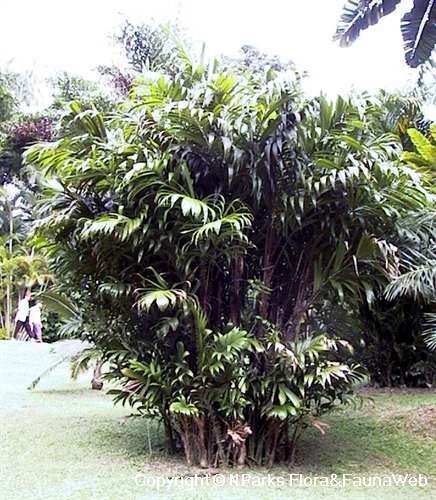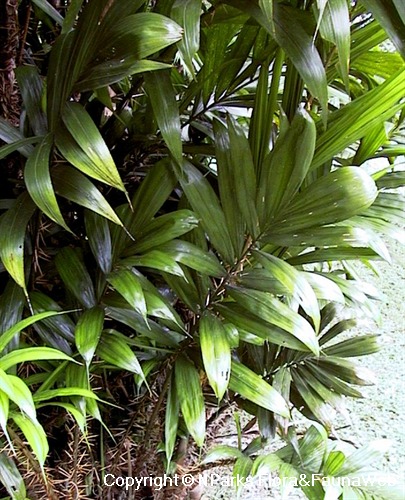
Back
Bactris guineensis
| Family Name: | Arecaceae (Palmae) |
| Synonyms: | Bactris horrida, Bactris minor |
| Common Name: | Prickly Pole, Tobago Cane |
Name
Classifications and Characteristics
| Plant Division | Angiosperms (Flowering Seed Plants) |
|---|---|
| Plant Growth Form | Palm (Clustered Habit) |
Biogeography
| Native Distribution | Central America to South America |
|---|---|
| Native Habitat | Terrestrial |
| Preferred Climate Zone | Tropical |
Description and Ethnobotany
| Growth Form | Bactris guineensis is monoecious, spiny clustering palm, about 0.6 - 3.5m tall. |
|---|---|
| Foliage | Leaf blade is about 20 – 50 cm long, pinnate and slightly bifid at the apex. 20 – 40 leaflets occurs on each side and are often widely spaced in between. Sheath is present and about 15 – 60 cm long. Spines are abundant on Bactris guineensis. They are dense and short on sheath; but scattered and longer on petiole and rachis. These spines are yellowish and black at the base and apex. |
| Flowers | Inflorescence occurs in between the leaves. Inflorescence comprises of 9 – 30 branches (8 – 11 cm long) and a mostly straight or slightly curved peduncles (10 – 20 cm long). Peduncular bract (25 - 35 cm long) is moderately covered with spreading, yellowish spines (to 1 cm long). Flowers are whitish-cream (about 0.4 cm wide) and both male and female flowers occur on the same plant. Male (staminate) flowers are borne in traids with female (pistillate) flowers; and not concentrated at the rachillae tip. |
| Fruit | Fruit is fleshy, and most globose but slightly flattened at the top (1.5 – 2 cm diameter). Fruit is 1 seeded and turns purple-black when ripe. |
| Associated Fauna | Pollination by beetles |
| Cultivation | Seeds can take up to 2 years to germinate. |
| Etymology | The genus name is greek for ‘cane’ or ‘staff’, which may refer to the use of the trunks of some of the smaller species (after removal of the spines). |
| Ethnobotanical Uses | Edible Plant Parts : Edible Fruits Food (Fruit or Vegetable) |
Landscaping Features
| Landscape Uses | Suitable for Roadsides, Parks & Gardens |
|---|
Fauna, Pollination and Dispersal
| Pollination Method(s) | Biotic (Fauna) |
|---|
Plant Care and Propagation
| Light Preference | Full Sun, Semi-Shade |
|---|---|
| Water Preference | Moderate Water |
| Plant Growth Rate | Moderate |
| Rootzone Tolerance | Well-Drained Soils |
Foliar
| Mature Foliage Colour(s) | Green |
|---|---|
| Leaf Area Index (LAI) for Green Plot Ratio | 4.0 (Palm - Cluster) |
Non - Foliar and Storage
| Trunk Type (Palm) | Clustering Habit, Aboveground |
|---|
Floral (Angiosperm)
| Flower Colour(s) | Cream / Off-White |
|---|
Fruit, Seed and Spore
| Mature Fruit Colour(s) | Black, Purple |
|---|
Image Repository
Others
| Master ID | 1303 |
|---|---|
| Species ID | 2596 |
| Flora Disclaimer | The information in this website has been compiled from reliable sources, such as reference works on medicinal plants. It is not a substitute for medical advice or treatment and NParks does not purport to provide any medical advice. Readers should always consult his/her physician before using or consuming a plant for medicinal purposes. |

